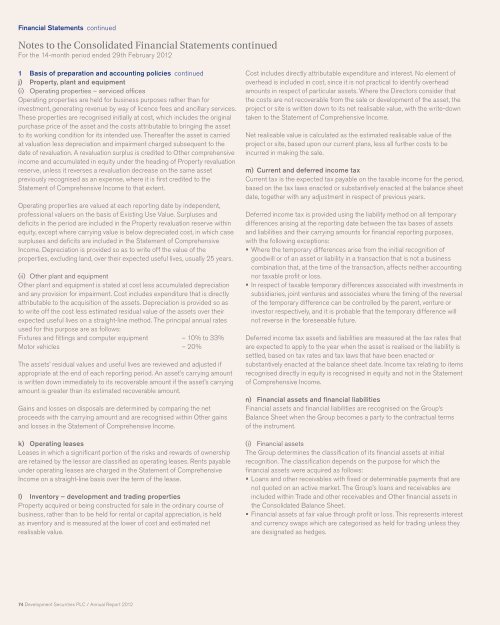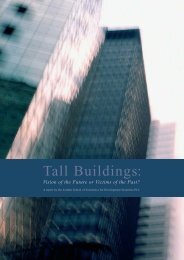Annual Report 2012 - Development Securities PLC
Annual Report 2012 - Development Securities PLC
Annual Report 2012 - Development Securities PLC
Create successful ePaper yourself
Turn your PDF publications into a flip-book with our unique Google optimized e-Paper software.
Financial Statements continued<br />
Notes to the Consolidated Financial Statements continued<br />
For the 14-month period ended 29th February <strong>2012</strong><br />
1 Basis of preparation and accounting policies continued<br />
j) Property, plant and equipment<br />
(i) Operating properties – serviced offices<br />
Operating properties are held for business purposes rather than for<br />
investment, generating revenue by way of licence fees and ancillary services.<br />
These properties are recognised initially at cost, which includes the original<br />
purchase price of the asset and the costs attributable to bringing the asset<br />
to its working condition for its intended use. Thereafter the asset is carried<br />
at valuation less depreciation and impairment charged subsequent to the<br />
date of revaluation. A revaluation surplus is credited to Other comprehensive<br />
income and accumulated in equity under the heading of Property revaluation<br />
reserve, unless it reverses a revaluation decrease on the same asset<br />
previously recognised as an expense, where it is first credited to the<br />
Statement of Comprehensive Income to that extent.<br />
Operating properties are valued at each reporting date by independent,<br />
professional valuers on the basis of Existing Use Value. Surpluses and<br />
deficits in the period are included in the Property revaluation reserve within<br />
equity, except where carrying value is below depreciated cost, in which case<br />
surpluses and deficits are included in the Statement of Comprehensive<br />
Income. Depreciation is provided so as to write off the value of the<br />
properties, excluding land, over their expected useful lives, usually 25 years.<br />
(ii) Other plant and equipment<br />
Other plant and equipment is stated at cost less accumulated depreciation<br />
and any provision for impairment. Cost includes expenditure that is directly<br />
attributable to the acquisition of the assets. Depreciation is provided so as<br />
to write off the cost less estimated residual value of the assets over their<br />
expected useful lives on a straight-line method. The principal annual rates<br />
used for this purpose are as follows:<br />
Fixtures and fittings and computer equipment – 10% to 33%<br />
Motor vehicles – 20%<br />
The assets’ residual values and useful lives are reviewed and adjusted if<br />
appropriate at the end of each reporting period. An asset’s carrying amount<br />
is written down immediately to its recoverable amount if the asset’s carrying<br />
amount is greater than its estimated recoverable amount.<br />
Gains and losses on disposals are determined by comparing the net<br />
proceeds with the carrying amount and are recognised within Other gains<br />
and losses in the Statement of Comprehensive Income.<br />
k) Operating leases<br />
Leases in which a significant portion of the risks and rewards of ownership<br />
are retained by the lessor are classified as operating leases. Rents payable<br />
under operating leases are charged in the Statement of Comprehensive<br />
Income on a straight-line basis over the term of the lease.<br />
l) Inventory – development and trading properties<br />
Property acquired or being constructed for sale in the ordinary course of<br />
business, rather than to be held for rental or capital appreciation, is held<br />
as inventory and is measured at the lower of cost and estimated net<br />
realisable value.<br />
74 <strong>Development</strong> <strong>Securities</strong> <strong>PLC</strong> / <strong>Annual</strong> <strong>Report</strong> <strong>2012</strong><br />
Cost includes directly attributable expenditure and interest. No element of<br />
overhead is included in cost, since it is not practical to identify overhead<br />
amounts in respect of particular assets. Where the Directors consider that<br />
the costs are not recoverable from the sale or development of the asset, the<br />
project or site is written down to its net realisable value, with the write-down<br />
taken to the Statement of Comprehensive Income.<br />
Net realisable value is calculated as the estimated realisable value of the<br />
project or site, based upon our current plans, less all further costs to be<br />
incurred in making the sale.<br />
m) Current and deferred income tax<br />
Current tax is the expected tax payable on the taxable income for the period,<br />
based on the tax laws enacted or substantively enacted at the balance sheet<br />
date, together with any adjustment in respect of previous years.<br />
Deferred income tax is provided using the liability method on all temporary<br />
differences arising at the reporting date between the tax bases of assets<br />
and liabilities and their carrying amounts for financial reporting purposes,<br />
with the following exceptions:<br />
Where the temporary differences arise from the initial recognition of<br />
goodwill or of an asset or liability in a transaction that is not a business<br />
combination that, at the time of the transaction, affects neither accounting<br />
nor taxable profit or loss.<br />
In respect of taxable temporary differences associated with investments in<br />
subsidiaries, joint ventures and associates where the timing of the reversal<br />
of the temporary difference can be controlled by the parent, venture or<br />
investor respectively, and it is probable that the temporary difference will<br />
not reverse in the foreseeable future.<br />
Deferred income tax assets and liabilities are measured at the tax rates that<br />
are expected to apply to the year when the asset is realised or the liability is<br />
settled, based on tax rates and tax laws that have been enacted or<br />
substantively enacted at the balance sheet date. Income tax relating to items<br />
recognised directly in equity is recognised in equity and not in the Statement<br />
of Comprehensive Income.<br />
n) Financial assets and financial liabilities<br />
Financial assets and financial liabilities are recognised on the Group’s<br />
Balance Sheet when the Group becomes a party to the contractual terms<br />
of the instrument.<br />
(i) Financial assets<br />
The Group determines the classification of its financial assets at initial<br />
recognition. The classification depends on the purpose for which the<br />
financial assets were acquired as follows:<br />
Loans and other receivables with fixed or determinable payments that are<br />
not quoted on an active market. The Group’s loans and receivables are<br />
included within Trade and other receivables and Other financial assets in<br />
the Consolidated Balance Sheet.<br />
Financial assets at fair value through profit or loss. This represents interest<br />
and currency swaps which are categorised as held for trading unless they<br />
are designated as hedges.






